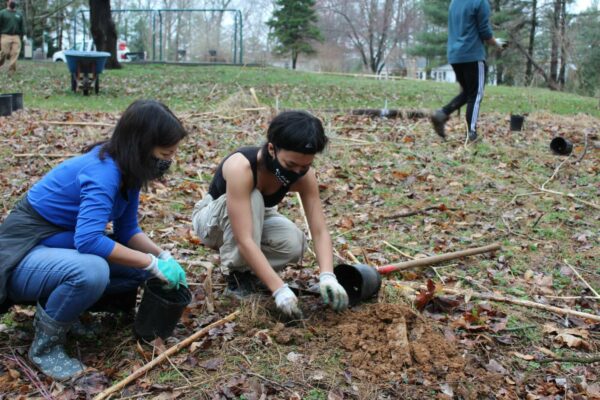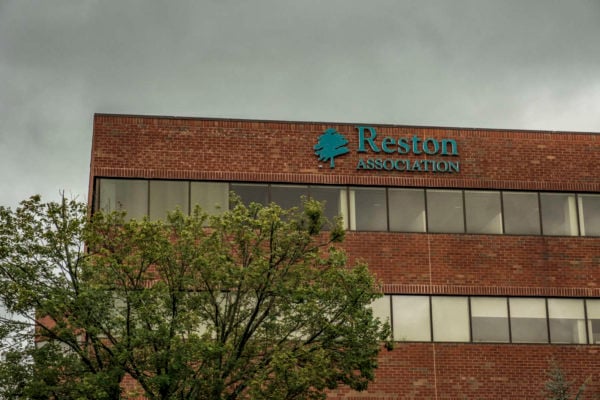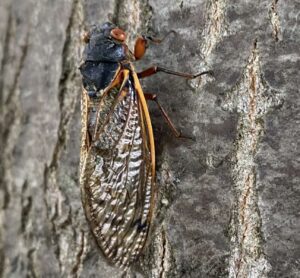
An eco-friendly alternative to lawn-mowing in the shape of teddy-bear-like four-legged creatures has arrived in Fairfax County.
The Fairfax-based LambMowers uses a flock of roughly 11 sheep to mow lawns in the county. Cory Suter, who graduated with a phD in economics, jump-started the company in order to allow sheep to eat weeds instead of poisoning the soil and ecosystem with herbicides.
“One of many things I learned through my studies is that modern society was treating the soil and clean water upon which all life depends like it was dirt,” Suter said. “Rotational grazing on Silvopasture land is one great way of building back dark carbon-rich soil, a rapidly depleting resource. Suburbs with their mix of trees and grass can be very effective at sequestering carbon when managed thoughtfully.”
County Joins Hope Card Program — The county has joined more than five dozen jurisdictions in the state in offering the Hope Card program. The initiative is a way to enforce a civil protective order and offer additional support to victims of family abuse. [Fairfax County Government]
Herndon Town Council to Discuss Van Buren Street Project — The town council meets today to award a contract for improvements along Van Buren Street. Other items up for discussion include the allocation of a trust to Herndon students and the upcoming Herndon festival. [Town of Herndon]
Reston Association Discusses Effects of Salt Use — The association is reviewing the environmental effects of de-icing salt. Salt that seeps. Into the environment can raise sodium levels in drinking water, harm fish and plans, and corrode vehicles and parking lots. [Reston Today]
Photo by Marjorie Copson

Top Schools Ranking Released — Some elementary and middle schools from Northern Virginia have made it to U.S. News & World Report’s annual ranking of the best schools in the country. Arlington Traditional School has the highest ranking in Virginia among elementary schools while Prince William County’s Mary G. Porter Traditional was ranked the best middle school in the state. [Reston Patch]
County Faces Invasion from Plant — You read that right. The county is facing an invasion from an aggressive plant with an otherwise unthreatening name. The plant wavyleaf basketgrass is spreading through natural areas across the county. The plant even sprouts a sticky substance that can bind itself to cloths, boots and animals, allowing the plant to continue to grow by spreading its seeds. [Fairfax County Government]
First Friends of Reston Fall 5K Set for This Weekend — The inaugural event takes place on Sunday at 8 a.m. at Brown’s Chapel Park. Online registration is open until tomorrow. [Reston Patch]

On the heels of last week’s sobering United Nations climate change report, Fairfax County is beginning to implement its first-ever Community-wide Energy and Climate Action Plan (CECAP), which sets goals for reducing greenhouse gas emissions.
Fairfax County staff delivered a final update of the CECAP to the Board of Supervisors during its environmental committee meeting on July 20. The board is expected to accept the report when it meets on Sept. 14.
The CECAP provides an inventory of current greenhouse gas emissions and recommends actions that the county and individuals can take to mitigate future emissions in order to achieve carbon neutrality within three decades.
“A lot of times, people feel like this problem is so big and out of their hands, that they feel like they can’t make a difference,” Fairfax County Office of Environmental and Energy Coordination Senior Community Specialist Maya Dhavale said. “I feel like it’s very timely that Fairfax County has been putting this plan and report together…We’re able to provide residents, business owners, and individuals in Fairfax County a path forward.”
Dhavale, who spearheaded the project, says staff have already begun the process of implementing the plan. That starts with community outreach, public education, and a review of existing county policies to determine how they line up with the proposed plan.
First proposed in 2018 and initiated in early 2020, the CECAP report was developed by a working group composed of environmental advocates, business representatives, civic association members, and other citizens.
As an overarching goal, the work group proposed that Fairfax County become carbon-neutral by 2050 with an 87% reduction in greenhouse gas emissions from 2005 levels.
The Board of Supervisors has already pledged to make county government operations — including building and facility energy use and transportation — carbon neutral by 2040 in conjunction with an updated operational energy strategy adopted on July 13.
The county’s recent push to prioritize environmental initiatives comes as the U.N. continues to sound the alarm on climate change as a crisis that’s already in motion and will only get worse without a substantial shift in human behavior.
In its latest report released on Aug. 9, the Intergovernmental Panel on Climate Change estimates that human activities are directly responsible for a roughly 1 degree Celsius climb in the global surface temperature from 1900 to 2019, contributing to retreating glaciers, rising sea levels, ocean acidification, and increased frequency and intensity of extreme weather events.
Even if future emissions are kept very low, global temperatures will continue going up until at least the mid-21st century and could very likely still be one to 1.8 degrees Celsius higher than 1900 levels by the end of the century, according to the report.
“Stabilizing the climate will require strong, rapid, and sustained reductions in greenhouse gas emissions, and reaching net zero CO2 emissions,” IPCC Working Group I Co-Chair Panmao Zhai said in a news release. “Limiting other greenhouse gases and air pollutants, especially methane, could have benefits both for health and the climate.”
In their report, the CECAP working group says the impact of climate change on Fairfax County is already evident in declining snowfall, more extremely hot days, heavier rainfall, and increased incidences of mosquito and tick-borne illnesses. Read More
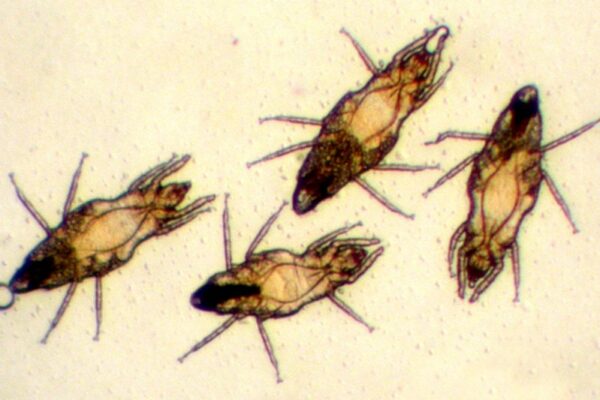
(Updated at 3:45 p.m.) Fairfax County residents are itching to understand the culprit behind weird skin reactions, possibly linked to bug bites, that have been reported throughout the D.C. region this summer.
As first reported by Reston Now’s sister site ARLnow, people in Northern Virginia and beyond are finding itchy red marks on their skin that are not quite mosquito bites and may be linked to oak leaf itch mites, an arachnid that’s nearly invisible to the naked eye.
Dr. Amir Bajoghli, a dermatologist who sees patients in McLean and Woodbridge in his Skin & Laser Dermatology offices, says he has seen an increase in the number of patients with this kind of issue, often involving raised red bumps or tiny blisters. The bumps can look like acne and be intensely itchy, similar to poison ivy.
“Because of all the cicadas we had, [the mites] were basically feasting on the eggs,” Bajoghli said, noting the mites can fall from the trees and be carried by wind. “Patients have even been telling me it’s worse than their experience with poison ivy.”
Oak leaf itch mites might cause red welts and affect people not only outdoors, but also indoors, potentially entering through window screens.
They typically feed on the larvae of small flies that form on leaves in oak trees. But local health officials suggest this year’s cicada emergence may be a factor, giving oak leaf itch mites another source of food from the cicada eggs laid in trees.
Still, Fairfax County health officials stressed that there’s no confirmation that the oak leaf itch mite is the cause of the bites, saying “it’s only a suspected cause at this time.”
“Although we are not certain what may be causing these bites, one of the suspected causes is the microscopic Oak Leaf Itch Mite,” Joshua Smith, the environmental health supervisor of the Fairfax County Health Department’s Disease Carrying Insect Program, said in a statement. “This mite has been presumptively associated with itchy bites in other regions of the U.S.”
States from Illinois to Texas have observed apparent outbreaks of the mite throughout recent decades.
“Most puzzling was the lack of any insect being seen or felt during the act of biting,” a research paper on a 2004 outbreak in Kansas noted.
Bajoghli, the dermatologist, recommends hydrocortisone as a starting point for treatment, which people can obtain without a prescription.
If that’s insufficient, doctors and dermatologists can provide prescription-strength remedies. He said over-the-counter antihistamines are also somewhat helpful.
“People can best protect themselves by limiting their time from under infested trees and by immediately removing and laundering clothing and then showering,” Penn State Extension researcher Steve Jacobs wrote in a patient-focused guide.
Whether the skin reactions involve that mite or something else, the Fairfax County Health Department has several recommendations for steps people can take to prevent problems with mosquitoes, ticks, and other pests:
- Use repellents. Products registered with the Environmental Protection Agency and recommended by the Centers for Disease Control and Prevention have active ingredients that include DEET, IR3535, picaridin, and more.
- Wear long pants and long-sleeve shirts outdoors.
- Shower after outdoor activities, washing away crawling ticks as well as doing a tick check.
- Launder clothes worn for outdoor activities. Ten minutes in the dryer on high heat will kill ticks on clothing.
- Avoid scratching bites. A cold compress or other products may help relieve itchiness.
People with questions and concerns are encouraged to talk with their health care provider.
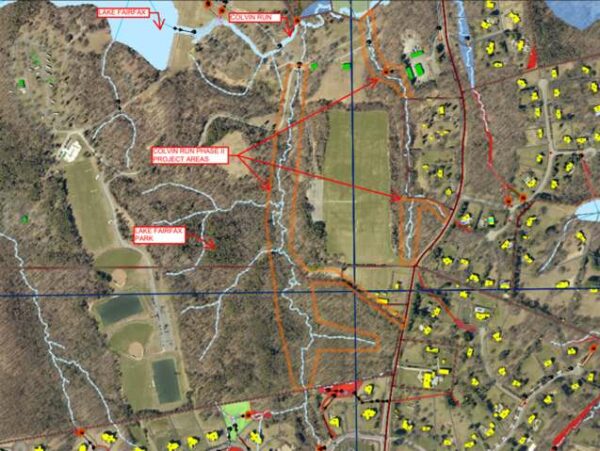
Plans to counter the ongoing degradation of Colvin Run at Lake Fairfax Park in Reston are in the works, but much like climate change and the development that have contributed to the stream’s erosion, it may take some time for them to become visible.
The Fairfax County Department of Public Works and Environmental Services (DPWES) is currently working on the final design for a second phase of its Colvin Run at Lake Fairfax Park stream restoration project, a department spokesperson confirmed to Reston Now.
Phase II of the project will focus on restoring approximately 5,000 feet of an unnamed tributary that feeds into Colvin Run. The project’s first phase addressed 2,219 feet of a channel downstream of the Lake Fairfax spillway and was completed on Aug. 8, 2017, according to the DPWES stormwater improvement projects map.
“The primary goal for both projects is to improve water quality,” DPWES spokesperson Sharon North said in an email.
According to DPWES, restoring Colvin Run is necessary to reduce stream bed and bank erosion, enhance the natural habitat, maintain channel connections within Lake Fairfax Park, and improve the water quality by removing nitrogen, phosphorus, and Total Suspended Solids.
The issues that the stream is experiencing stem from a combination of increasing development in the area and the growing intensity of storms.
“Colvin Run and its tributaries are downcutting, widening and re-aligning in response to hydrologic changes after upstream development and the increased intensity and frequency of storm events,” North wrote. “This channel evolution results in soil erosion, habitat degradation and decreased water quality.”
The two phases of the Colvin Run project were determined by a scoping team with input from engineers, ecologists, landscape architects, construction managers, arborists, and other experts who assessed the area’s current conditions as well as “the potential for ecological and water quality improvement,” North says.
Colvin Run Phase I involved raising the channel’s elevation, installing boulder grade control structures that imitate bedrock outcroppings to prevent future erosion, and adding native vegetation to help stabilize the soil and surrounding habitat.
For Phase II, North says the design will call for stone and wood grade control structures to create pools, riffles, and “a base-flow channel” to help the channel and floodplain capture excessive sediment that flows in from upstream.
In a May 26 update, the project website says completion of the final design and approval of construction for Phase II are expected to come this summer, but DPWES did not respond by press time when asked whether that is still the case.
Construction on the project isn’t scheduled to begin until the summer of 2023, depending on future budget availability.
“A gap in time between the completion of design and the start of construction for a project is normal,” North said, noting that stormwater management projects typically need to get separate authorizations for design and construction.
Construction on the project’s second phase carries an estimated cost of $3.2 million that would be supported by Fairfax County’s Stormwater Service District tax.
Anticipated impacts from construction include trail closures, trail detours, noise, and increased traffic from trucks delivering equipment and materials. Construction vehicles will access Colvin Run from Lake Fairfax Park off of Lake Fairfax Drive and Hunter Mill Road.
Map via Fairfax County Department of Public Works and Environmental Services

Reston Association is monitoring a blue-green algae bloom that has emerged at Lake Audubon.
RA announced yesterday (Tuesday) that its watershed staff have found that the bloom contains the algal toxin microcystin, but tests of the water suggest the current levels of the toxin are low enough that no restrictions on recreation at the lake are necessary.
“However, environmental conditions such as increased heat or nutrients can affect levels and caution is advised,” RA said in the notice. “As always, no swimming is allowed at any time in Reston’s lakes and pet owners should check for floating blue-green algae before allowing pets in the water.”
The Environmental Protection Agency describes microcystin as “a potent liver toxin and possible human carcinogen.” It is the most widespread type of blue-green algae, also known as cyanobacteria, which may cause issues ranging from allergic reactions to gastroenteritis, liver and kidney failure or death, though cases of severe human health issues are relatively rare.
According to RA, algae blooms often appear when temperatures rise, but they usually occur later in the summer.
The National Oceanic and Atmospheric Administration reported on July 9 that June 2021 was the hottest June on record in the U.S., though temperatures were average for this time of year in the D.C. area.
While fishing and boating on Lake Audubon are still permitted, users should “be careful to avoid the water,” RA says.
RA recommends staying in or on watercraft at all times, avoiding contact with algae, and not drinking water from lakes. The association also discourages people from eating fish caught in lakes.
“RA will be monitoring the lake closely to see if the toxin levels increase or decrease and will adjust the status from caution, danger or clear accordingly,” RA said.
Algae blooms have been a recurring issue at Reston lakes, including at Lake Audubon, which had a small bloom last August.
A particularly large bloom that appeared in Lake Thoreau that same month prompted RA to commit to spending more money on lake management this year in order to take a more proactive approach.
In addition to posing a potential health risk when in high concentrations, algae blooms can be devastating to freshwater ecosystems, as they can block out sunlight, clog fish gills, and create oxygen dead zones where no aquatic life can survive. Scientists say human activities and climate change are leading to more common and more toxic blooms.
According to the Reston Association, there is no method of removing toxins from lakes, but people can help prevent the nutrients that produce algae blooms from entering the water.
“The public can help reduce the occurrence of blue-green algae blooms by preventing nutrients (nitrogen and phosphorus) from entering waterways through responsible use of lawn fertilizers, picking up pet waste, and controlling sediment erosion,” RA said in its statement.
Reston Association Watershed staff have been monitoring a blue-green algae bloom on Lake Audubon. For more details please the attached image.
Please send any questions or concerns to our Watershed team at [email protected]. pic.twitter.com/GE9ug77PPi
— Reston Association (@RestonOnline) July 20, 2021
Photo via Reston Association/Facebook

Fairfax County took a first step yesterday toward potentially taxing plastic bags used by grocery stores and other retailers.
The Board of Supervisors voted 9-1 yesterday (Tuesday) to direct county staff to draft an plastic bag tax ordinance, but even supporters of the measure allowed that there remains some uncertainty around how exactly the tax would be implemented if approved.
“Let’s definitely try this, but we may end up back in the General Assembly in the foreseeable future to try to get clarification,” Hunter Mill District Supervisor Walter Alcorn said, noting that the county is subject to the Dillon rule. “…This is probably a prime example of when we probably need a little more flexibility, but I’m all for it.”
The Virginia General Assembly passed legislation during its 2020 session giving localities the authority to impose a five-cent tax on disposable plastic bags, starting on Jan. 1, 2021.
Roanoke became the first jurisdiction to take advantage of the new law when it adopted an ordinance in May that’s set to take effect on Jan. 1, 2022.
Under House Bill 534, which was identical to Senate Bill 11, cities and counties can tax each disposable plastic bag provided to customers by grocery stores, convenience stores, and drugstores. The tax would not apply to plastic bags designed to be reused, garbage bags, bags used to hold or package food to avoid damage or contamination, and ones used to carry prescription drugs or dry cleaning.
The legislation allows retailers to retain two cents from the imposed tax on each bag until Jan. 1, 2023, when the amount that goes to retailers drops to one cent.
That “dealer discount” provision is intended to help offset additional expenses retailers might incur from adjusting their operations, but it also puts added pressure on localities to adopt an ordinance as soon as possible, according to Board of Supervisors Chairman Jeff McKay.
“We want to start the process of the ordinance review, looking at the language, the public input, because the clock literally is ticking,” McKay said.
Complicating matters is the fact that the Virginia Department of Taxation has not yet released guidelines clarifying what a plastic bag tax ordinance should look like, leaving questions around the definition of a grocery or convenience store, how the tax will be enforced, and other issues, County Executive Bryan Hill told the board in a Nov. 30 memorandum.
Braddock District Supervisor James Walkinshaw, who introduced the board matter on Tuesday, said the draft guidance that county staff has seen and provided input on through the Northern Virginia Regional Commission will clear up many of those questions.
He hopes the guidelines will be finalized soon so county staff can incorporate them into the ordinance that they have now been directed to draft and present to the board in September.
Springfield District Supervisor Pat Herrity, the lone Republican on the board, opposed the board matter, taking issue with the timing of the proposal. Read More
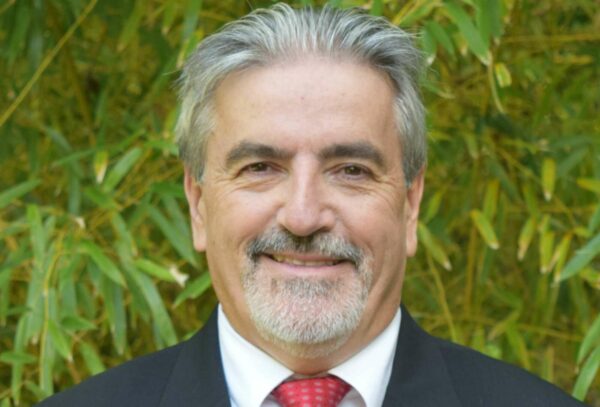
The Reston-headquartered Fortune 500 company Science Applications International Corp. known as SAIC (12010 Sunset Hills Road), has hired its first chief climate scientist.
Stephen Ambrose joined the information technology and engineering government contractor in early May. His decades of previous experience in climate science includes a 25-year tenure at the National Oceanic and Atmospheric Administration.
“Climate change is one of the grand challenges of our time,” Bob Genter, president of the defense and civilian sector at SAIC, said in a news release. “Stephen brings a wealth of experience and expertise to SAIC as we continue to help our customers rise to this challenge with solutions scaled to meet all levels of climate and disaster risk and adaptation.”
Ambrose is particularly interested in assisting government customers with strategic planning for disaster responses and preparation not just at the federal level, but also states and localities.
“How are we prepared for these disasters? More hurricanes. Stronger hurricanes. Flooding,” he said. “The most opportunity we should go forward with is…in that effort.”
Ambrose’s primary responsibilities include helping the company understand climate change and its impacts, examining the available science and technology and applying those to climate questions, and working with customers to address issues related to climate change, resilience, and adaptation.
“His experience will guide SAIC’s efforts to support government customers as they advance solutions to deal with the impacts of climate on land, air, sea, wildlife, and civilizations around the world,” the company said in the news release. “He’ll also promote solutions for measuring and addressing climate challenges, leveraging SAIC solutions and capabilities in data science, modeling, artificial intelligence, machine learning, and analytics.”
In addition to working for NOAA, Ambrose’s career includes stints with the Department of the Interior, Environmental Protection Agency, and NASA, where he spent 10 years as a program manager executive for disasters, homeland security, and water resources.
Before joining SAIC, he was a senior advisor and program manager at General Dynamics Information Technology (3150 Fairview Park Drive, Falls Church).
With about 26,000 employees, SAIC primarily contracts with the Army, Navy, and agencies in the Department of Defense, but it’s also served NASA, the Department of Homeland Security, and other federal partners.
In March, the company’s annual filing showed $7 billion in revenue for the past fiscal year — 98% of it involving the federal government.
SAIC’s decision to hire a chief climate scientist comes amid a renewed focus in the U.S. on addressing climate change and other environmental issues.
As one of his first executive actions, President Joe Biden set a goal to eliminate carbon pollution from the power sector by 2035. He also wants the country to cut its greenhouse gas emissions in half from 2005 levels and make all electricity renewable by 2035.
“You can tell by the administration and the focus on climate change, it’s just everyday…coming out from that so quickly, that we have to respond to that,” Ambrose said.
On a local level, the Fairfax County Board of Supervisors pledged yesterday (Tuesday) to achieve carbon neutrality for all government operations by 2040, following up on a recommendation issued by the county’s Joint Environmental Task Force last year.
However, with county government facilities accounting for a relatively small amount of emissions, the private sector also needs to do its part to combat climate change, and Ambrose says SAIC is well-equipped to contribute.
He says his work will bring the company “to the forefront” of this issue, building off of ongoing efforts with different government agencies, from the Federal Aviation Administration to military bases.
“The team I have is growing rapidly,” Ambrose said. “I consider all of SAIC my team because I’m horizontal across all aspects of it.”
Ambrose says his first year on the job is more focused on planning, including developing a five-year plan with milestones for the company. He’s also working on some events to engage employees and the general community, starting with a public forum that will include a panel of speakers from NASA, NOAA, and universities.
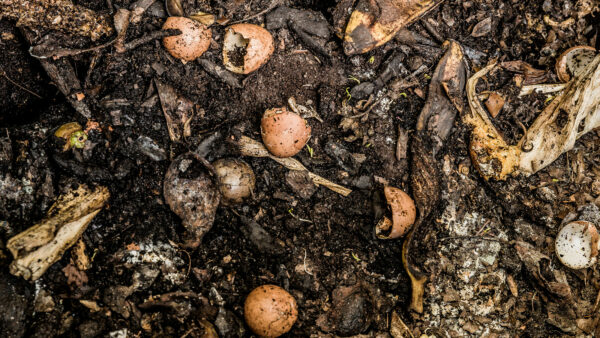
Save those rotting veggies and bits of meat left over from last night’s dinner, because Fairfax County is expanding its composting program.
As of yesterday (Wednesday), residents can now bring their food scraps to four county farmers markets for composting. The locations include the Herndon Farmers Market, which operates from 8 a.m. to 12:30 p.m. on Thursdays.
Food scrap composting turns waste into a resource. Those wrinkling carrots or uneaten bread crusts can be transformed over time into natural fertilizer, putting nutrients back into the soil.
Proper composting can also prevent food waste from ending up in landfills and streams, taking up space and potentially damaging the ecosystem.
“The county is working to divert as much waste from disposal as possible,” Fairfax County Department of Public Works spokesperson Sharon North said in an email. “In the past few years, we have focused on glass recycling and reducing contamination to improve single stream recycling…Providing food scraps drop off locations will help divert this compostable material from disposal.”
North says food scraps can account for as much as 20% of waste, but nearly all of it can be composted, including meat, bones, dairy, vegetables, fruit and bread.
Some food-related paper products, such as paper plates, paper towels, and napkins, can be composted as well, as long as there’s no cleaning products or bodily fluids on them. Plastic bags, dryer sheets, yard waste, fats, oils, grease, tin foil, and foam containers, however, should never be composted.
Fairfax County first implemented a composting pilot program in November 2020 at two larger locations: the I-95 Landfill Complex in Lorton and I-66 Solid Waste Transfer Station in Fairfax.
North says the initial pilot program was a success, prompting county leaders to discuss options for an expansion.
“One of the main things we learned is that our residents are willing to separate out food scraps and bring them to compost drop off locations,” she writes.
The I-95 landfill and I-66 transfer station will remain permanent composting drop-off sites. The four farmers markets that are now part of the program’s expansion were specifically chosen due to their accessibility and central locations within the county.
Three of the markets, including the Herndon farmers market, are seasonal and managed by the Fairfax County Park Authority. The Mosaic District farmers’ market is a year-round, private market operated by FreshFarm.
“Making locations more accessible throughout the county at Farmers Markets will allow for more opportunities to drop off food scraps for composting rather than having that material in the trash,” North said.
The compost program is expected to cost the county an estimated $50,000 annually.
Photo via Philip Cohen/Wikimedia
(Updated at 6:20 p.m.) While most schools are wrapping up and kids are headed into vacation mode, Flint Hill School junior Zoe Bredesen is making her mark on Reston’s environment by organizing tree plantings.
A Girl Scout since she was 5, Bredesen is now pursuing the organization’s highest award with her goal to plant at least 400 trees throughout Fairfax County, and she is working with Reston Association to achieve it.
The Girl Scout website says scouts can earn the Gold Award by finishing at least 80 hours of community service and showing “proof that not only can she make a difference, but that she already has.”
Bredesen has been passionate about the environment for as long as she can remember.
“I grew up in a very forested area,” she said. “So, I’ve always just really loved trees and nature, and climate change is something that I’m very concerned about. It’s one that I think demands radical, substantial effort to combat.”
Bredesen recognized that her ability to bring about the large-scale changes necessary to address climate change on a global level was limited, so she decided to focus on a project that would make an impact in her local community.
“I can’t shut down BP Oil or make every county use sustainable energy,” Bredesen said. “…One thing that I can just do as just me is plant trees to take in some of the [carbon dioxide] and put out fresh oxygen to combat atmosphere pollution. So, that’s just what I’m doing as a single person trying to make a difference.”
Bredesen has now been working on the project for two years with assistance from fellow students in the environmental club that she leads at her school. The group has planted 250 trees to date.
While the COVID-19 pandemic slowed their work due to the need to minimize the risk of close contact in large groups of people, Bredesen and her team have stayed committed to her goal.
Most recently, she worked with Reston Association volunteers and environmental resource staff to plant 40 trees along Moorings and North Shore Drive.
The next planting event will take on June 26 at 10 a.m., again in collaboration with RA.
In order to attend, participants must sign a COVID health waiver. Anyone who is interested in helping can contact Volunteer Reston Manager Ha Brock at [email protected].
Bredesen says she started working with RA, because she needed to get permission to plant on the grounds of their facilities. She has collaborated with other organizations as well, including Claude Moore Park and a homeowners’ association in Ashburn.
During her project, Bredesen has been helping train volunteers on how to plant and take care of the trees. She will be turning to the Reston community for help at the next planting, since many of her usual helpers from the school environemntal club will be away on summer vacation at that time.
Bredesen says spring is typically the best time to plant trees because that’s when they have the best chance of surviving. Summer into the early fall works as well, but trees have the “lowest chance of succession” during the winter months.
“Now that more people are getting vaccinated and covid restrictions are loosening, if we could get more people coming together to plant trees with the common goal of reducing our carbon footprint, I think that’d be awesome,” Bredesen said.
Photo via Volunteer Reston/Facebook
Reston Association is looking at potentially introducing greater electric vehicle initiatives, but a months-long evaluation of the proposal’s feasibility has revealed some hurdles.
During the RA Board of Directors meeting on May 27, COO Larry Butler and Cam Adams, the director of covenants administration, presented findings from a study of electric vehicles and charging stations that the board unanimously approved on Feb. 25.
One of the motions approved in February directed RA staff to study the possibility of installing electric vehicle charging stations at one or more RA facilities. The other motion called for staff to review the potential replacement of the association’s current fleet of fossil-fueled vehicles over the next 10 years.
With notes from consulting firm Kimley-Horn, Butler said at last week’s meeting that the availability of electric vehicles does not meet the general needs necessary for the complete conversion of the fleet at this time.
Since the majority of RA’s fleet consists of trucks, the current design for electric trucks does not meet the association’s needs, according to Butler, who noted that they typically have shorter beds than fossil-fuel versions and lack power capabilities for towing, hauling, or snow plowing.
However, he clarified that “this is really just the beginning of this investigation,” and the review to switch to electric vehicles will continue.
“The market isn’t there yet. It’s moving very fast,” Butler said.
He told the board that Kimley-Horn had recommended reevaluating electric vehicle options “every two to three, maybe four, years.”
“As the market becomes more robust with the types of vehicles, the cost of those because the competition will also come down…we’ll be in a better place to really look at more wholesale conversion,” he said.
There will remain consideration in the budget for electric vehicles, but a full conversion is not yet possible, in Butler’s opinion.
“We are in the early stages of going from fossil to electric. You’ve raised, I think, what are the major issues,” RA Director Bob Petrine said after Butler’s presentation. “I think the biggest single one is there isn’t at the moment a good break-even point. The trucks that are in offing are more toys than they are work trucks.”
Adams followed this discussion by addressing the board’s Jan. 28 directive to study how RA, the Design Review Board, and the covenants committee can assist clusters considering the installation of EV charging stations.
He suggested that a draft guideline could be presented to the DRB when it meets in July but estimated a final draft will take about five months to prepare, potentially for presentation in October.
While the Design Review Board has already approved six separate types of EV installations, it does not have an established guideline “that the DRB can objectively review that application,” according to Adams.
He added that the board would probably review any request submitted for an EV installations and that each “will evaluate it in a certain level of reasonableness that’s appropriate.”
(Updated at 4 p.m.) A Herndon car wash that discharged green liquid that ended up in Sugarland Run Stream received a formal notice of violation on Friday (May 28) from the Virginia Department of Environmental Quality, a regional official says.
Flagship Carwash Center of Herndon at 632 Grant Street does have a permit to discharge, according to both a car wash representative and DEQ.
However, the green liquid was being discharged into a storm sewer that goes into Sugarland Run due to a malfunctioning of the car wash’s water reclamation system malfunctioning, says DEQ official Mark Miller, who manages regional enforcement and pollution response for Virginia’s northern region.
Miller says the presence of the discharge in Sugarland Run has been observed multiple times by both DEQ officials and town staff members.
As a result, the business will be notified that it is in violation of its general DEQ permit. The discharge is believed to be a mix of water and car wash detergent, but it is not thought to be harmful to the stream.
“Staff from the town, Fairfax County DPWES, Fairfax County Fire Department, and the Virginia DEQ all performed independent tests on the discharge and did not find any contaminants in the stream that are known to be harmful to the environment,” Town of Herndon spokesperson Anne Curtis told Reston Now by email.
Curtis says DEQ is now in charge of the investigation and is “in contact with the property owner to resolve the illicit discharge.”
This issue was first brought to the public’s attention during a Herndon Town Council work session on May 18. In the work session, Deputy Director of Public Works John Irish noted that town staff were aware of the situation and had recently observed the discharge themselves.
Flagship Carwash Center of Herndon managing member Guy Paolozzi told Reston Now that the business is currently conducting its own investigation to determine why the discharge is green.
Until both the car wash and DEQ complete their investigations, Paolozzi says, the car wash will stop discharging.
Flagship Carwash Center currently has five Virginia locations and 10 locations across the region.
Miller says the notice of violation was drafted and sent out last week. The intent of the notice is to get the problem fixed under a timeline. These types of violations are not uncommon, and they can end with the business fixing the issue without any further consequence.
However, a civil charge (a fine) could be imposed depending on the findings of DEQ’s investigation.
A section of Sugarland Run south from where the discharge has been observed is about to undergo a restoration. The long-running project was first approved in August 2018.
Work includes replanting vegetation, placing in-stream structures, and installing brush mattresses.
Construction and restoration is expected to be completed in early 2022.
The cicadas are here, along with a new rap about the insects from local hip-hop artist MC Bugg-Z.
“Brood X-cellence” is a deep rhyming dive into the entomology, science, and emergence of Brood X, the periodical cicadas that are just now surfacing from their 17-year slumber underground.
Lines like “I have been chilling underground with my friends sippin on root juices” and “It’s a fitness thing, you’re witnessing predator satiation” will certainly have wings flapping and red eyes darting.
The song is written and performed by MC Bugg-Z, who isn’t just any old bug-loving underground hip-hop artist. He’s an entomologist and biologist who works for Fairfax County.
“I’m part of the Fairfax County Health Department’s Division of Environmental Health and, inside the Division of Environmental Health, we have the disease-carrying insects program,” Andy Lima said. “That’s my normal, real-life job.”
Lima has been writing and recording underground hip-hop since his college days in the mid-2000s with a focus on intelligent lyric writing.
“It’s more about the rhymes than the beats,” Lima said. “I love to convey the knowledge about the things I love and the world I know…by putting it into hip-hop song form.”
In Lima’s case, that’s bugs, and this isn’t his first foray into the emerging genre of insect rap.
In 2016, he released “Zika 101” about protecting oneself from disease-carrying mosquitoes. In 2018, there was “Tick-Check 1-2” about checking for ticks and avoiding Lyme Disease, followed a year later by “West Nile Story.”
While cicadas are not known to carry disease, Lima couldn’t skip the opportunity for a new song about a bug.
“Brood X-cellence” is a remix or sequel of sorts to a cicada rap he wrote back in 2004, when the brood last emerged. He was a student at Indiana University back then, and the din of the cicadas could actually be heard in the background of the recording.
“I was going to just re-release that one this year and just felt like there were things about the song that I wanted to change, new information that I wanted to include and, also, some errors,” Lima said. “I’ve learned some stuff over the past 17 years…Now, the focus is much more on the biology of it as opposed to the spectacle itself.”
When he writes songs, Lima takes a reverse-engineered approach. He thinks about how he wants to end a line and then finds a rhyme to match it.
“I don’t shy away from the scientific words because they are multi-syllables,” Lima said. “You can often find a way to rhyme them or, even, define some of these terms [in the rhyme]…like predator satiation.”
It took about two weeks to write, re-work, and record “Brood X-cellence.” The beat was provided by Kelton Williams, another Fairfax County employee who Lima met while helping with COVID-19 emergency response.
“He’s a great musician,” said Lima. “As soon as I heard [his beat], I thought ‘Oh man, this is going down.'”
The main takeaway that Lima wants folks to get from the song is that this cicada takeover is an incredibly rare and amazing occurrence.
“It’s a fleeting event, a miracle of nature,” he said. “It really only occurs in the eastern half of the United States and nowhere else in the world…It’s just so rare that the public is kind of overrun with insects.”
He hopes his bug rap educates, entertains, and allows folks to have a little fun after a difficult year.
With the temperatures warming, particularly in the evening, the cicadas are expected to come out of the ground en masse within a matter of days, looking to play their own song.
“We’re really going to see the surge that’s just beyond,” Lima said. “So, hopefully my song is well-timed.”
The Reston National Golf Course has launched a new study group to help understand the property’s past and current conditions and future plans for the neighborhood’s natural environment.
Funded by Virginia Investment Partners LLC, which owns the 168-acre golf course, the Reston National Neighborhood Study Group is focusing on six primary categories: open space, amenities, tree canopies, safety, housing costs, and water quality.
The group hosted its first community meeting on May 13 with the Hunters Green community, and at least additional conversations are planned, according to study group leader Greg Hamm.
As founder and president of the real estate planning firm New City Enterprises, Hamm represents the developers Weller Development Cos. and War Horse Cities, which purchased the golf course in 2019.
Hamm says the community conversations are intended to provide transparency for the study group’s work and opportunities for public engagement, particularly with adjacent neighbors like the Hunters Green Cluster, which shares almost six miles of property with the golf course.
“This is a very important piece of property, and it’s a very important topic and issue to many people,” Hamm said. “…It’s a big responsibility on us to really listen, engage and be creative and thoughtful in how we are stewards of this property and this important piece of the community. So, there are going to be lots of ideas, lots of opinions, lots of very important concerns that we have to address.”
The conversations will touch on shared property lines, trees, and the vegetative state of the surrounding property, including how to address invasive plant species, along with other challenges identified by the study group and neighbors.
Other topics include understanding the trail network and engaging in conversation about permanent open spaces, a recurring concern in Reston when it comes to golf courses.
While an effort to update Reston’s comprehensive plan is ongoing, Hunter Mill District Supervisor Walter Alcorn has maintained that he would not support amending the plan to allow for development on the area’s two golf courses, though a proposal to build townhomes near the Hidden Creek Country Club course is currently working its way through Fairfax County’s planning process.
Hamm says the Neighborhood Study Group will be guided by the seven founding principles laid out by Reston founder Robert E. Simon.
“We think that keeping in the spirit of Reston and master planning, and community building, there’s some ways we could go about possibly addressing some of these things that could be very positive,” Hamm said.
Hamm added that these conversations will not result in an overnight transformation, but he hopes to encourage an open dialogue so the study group can work with surrounding community members and learn about their concerns or ideas.
“We want to make sure we genuinely thought through and understand the major underpinning issues the community has about our future and their future,” Hamm said. “Part of that is enabling them to understand what’s happening already.”
Photo via Reston National Golf Course/Facebook



